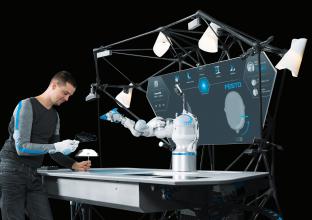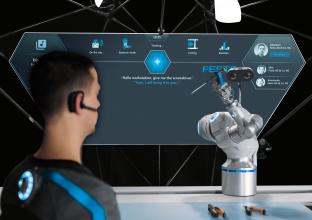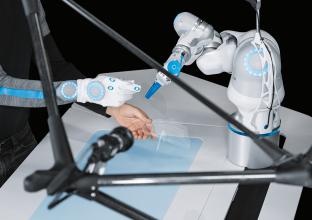
BionicCobot could revolutionise the textile industry
Rising wages are forcing an increasing number of textile manufacturers in the Far East to consider intelligent automation technology. Festo will demonstrate the potential of its concept study featuring the BionicWorkplace with the BionicCobot as a solution for the textile industry at ITMA 2019, the world's leading textile machinery show, in Barcelona.
The Chinese garment industry is going through a period of change. Rising wage costs are driving the need for increased automation, while ever more demanding customers are looking for better quality. China produces more clothing than any other country on earth. With an average hourly wage of around US$5.20, Chinese textile workers now not only earn more than their counterparts in emerging economies, such as Thailand (US$2.30) or Mexico (US$3.90), but are even catching up with a number European countries, such as Greece, where the hourly wage is US$6.0.
A growing number of Chinese textile manufacturers are turning to increased automation. More and better machines are replacing existing labour-intensive manual production. They can reduce the cost pressure while at the same time delivering faster and more precise results. This change saw the number of workers employed in Chinese textile factories fall by 14%, from 9.1 to 7.8 million, between 2015 and 2017. Industry experts expect this trend to continue. However, the machines and systems used up to now cannot perform every task.
Cooperating robot
What if there were a cooperating robot that could perform simple feeding tasks? Automation technology could bring about improvements in situations where sewing machinists receive different pieces of fabric that are unsorted. This could be particularly important given that wage developments in China may result in a shortage of workers for such tasks in the medium term.
Linear and three-dimensional gantries are already at the limits of their flexibility when it comes to such tasks. The electrically operated cooperating robots used up to now are too expensive for the textile industry. The BionicWorkplace from Festo could provide a solution. Equipped with numerous sensors and the required intelligence, this concept study from Festo features the BionicCobot, a pneumatically operated cooperating robot.
Flexible pneumatics
Robots can be used as assistance systems to perform tasks and ease the load on people, particularly for monotonous or hazardous activities. Thanks to their natural motion pattern and the flexible pneumatic components used, bionic lightweight robots are ideal for safe collaboration between people and robots. They could represent an inexpensive alternative to classical robot concepts.
An interesting approach is a pneumatically operated cobot, which requires fewer and less expensive components than all previous electrically operated cooperating robots. The latter require a relatively expensive spindle system for each of its seven axes, including motors, spindles, frequency converters and displacement encoders. A pneumatic robot, on the other hand, requires only one rotary vane drive per axis.
Gentle motion sequences thanks to digitised pneumatics
The BionicCobot generates its motions using air pressure, which also makes it flexible. This enables it to interact directly and safely with people. The basis for this is digitised pneumatics. The automation platform Festo Motion Terminal VTEM controls the movements using Motion Apps. Depending on the requirements, the movements can be powerful and dynamic or sensitive and yielding so that even in the case of a collision with a person, the system does not represent any hazard. The Festo Motion Terminal combines high-precision mechanics, sensor technology as well as control and measuring technology in the tightest of spaces.
Cloud-based, teachable intelligence provided by Google Commons and camera systems from Festo, for example, could open up completely new and intuitively simple perspectives for operators during commissioning and operation.
Inspired by nature
The motion patterns of the BionicCobot simulate those of the human arm, from the shoulder through to the upper arm, the elbow, the lower arm and the gripping hand. Like the blood vessels and nerve fibres in the human body, the compressed air lines run safely inside the structure and thus cannot be bent. They supply the pneumatic rotary vane drives, which are located in the seven joints of the robot arm. Also installed in each joint are two pressure sensors and an absolute encoder with CAN bus for determining the position data. This means that the BionicCobot is able, like its biological inspiration, to execute very sensitive motions.
Intuitive motions
The BionicCobot can be equipped with various grippers, depending on the application. It is operated intuitively via a specially developed graphic user interface so that users can teach-in and parameterise the required actions very easily using a tablet. The work steps can then be arranged in a timeline in any order by dragging and dropping. A complete movement sequence can be displayed virtually and simulated at the same time. The interface between the tablet and the Festo Motion Terminal is the open-source platform ROS (Robot Operating System), which is used to plan the paths of the kinematic system.
The artificial intelligence and machine learning capabilities embedded in the Festo BionicWorkplace transform workplaces into learning systems that continuously evolve and adapt to requirements. In the BionicWorkplace, people collaborate with the robot arm as well as numerous assistance systems and peripheral devices, which are networked and communicate with each other. The technology supports the workers and makes their jobs easier when carrying out strenuous or hazardous activities.
Learning system thanks to sensor technology and artificial intelligence
The entire workplace is ergonomically designed and can be individually adapted to people, even including the lighting. Sensors and camera systems record the positions of the worker, components and tools so that the worker can intuitively control the BionicCobot using movement, touch or speech. Software simultaneously processes all the camera images and inputs from the various peripheral devices. It uses this information to create the optimal program sequence. The system learns something new with every action solved and thus optimises itself. As a result, a controlled, programmed and set sequence gradually turns into a much freer working method.
Sharing and using expertise worldwide
The processes and skills of the BionicWorkplace, once learned and optimised, can easily be applied to other systems of this type in real time and made available on a globally. In future, it will be possible to set up workplaces as part of a worldwide network and to share knowledge, with the communication adapted to the worker's national language. This will lead to a more flexible and decentralised production environment, where workers can retrieve production orders via Internet platforms, for example, and complete them in cooperation with the machines, adjusted to individual customer requirements. Remote manipulation of the workplace is also a possibility.
Festo is a global player and an independent family-owned company with headquarters in Esslingen am Neckar, Germany. Festo has set standards in industrial automation technology and technical education ever since its establishment, thereby making a contribution to sustainable development of the environment, the economy and society. The company supplies pneumatic and electrical automation technology to 300,000 customers of factory and process automation in over 35 industries. Digitalization, AI and the LifeTech sector with medical technology and laboratory automation are becoming increasingly important. The products and services are available in 176 countries. With about 20,800 employees in over 250 branch offices in around 60 countries worldwide, Festo achieved a turnover of around €3.81 billion in 2022. Each year around 7% of this turnover is invested in research and development. In this learning company, 1.5 % of turnover is invested in basic and further training. Festo Didactic SE is a leading provider of technical education and training and offers its customers worldwide comprehensive digital and physical learning solutions in the industrial environment.



